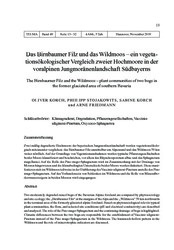Das Birnbaumer Filz und das Wildmoos – ein vegetationsökologischer Vergleich zweier Hochmoore in der voralpinen Jungmoränenlandschaft Südbayerns
Korch, Oliver
Stojakowits, Philipp
Korch, Sabine
Friedmann, Arne
49: 13 - 32
Korch, Oliver; Stojakowits, Philipp; Korch, Sabine; Friedmann, Arne, 2019: Das Birnbaumer Filz und das Wildmoos – ein vegetationsökologischer Vergleich zweier Hochmoore in der voralpinen Jungmoränenlandschaft Südbayerns. In: TELMA - Berichte der Deutschen Gesellschaft für Moor- und Torfkunde, Band 49: 13 - 32, DOI: 10.23689/fidgeo-3670.
 |
View/
|
Zwei mäßig degradierte Hochmoore der bayerischen Jungmoränenlandschaft werden vegetationsökologisch miteinander verglichen: das Birnbaumer Filz unmittelbar am Alpenrand und das Wildmoos 59 km weiter nördlich. Auf der Grundlage von Vegetationsaufnahmen werden typische Pflanzengesellschaften beider Moore klassifiziert und beschrieben, vor allem das Rhynchosporetum albae und das Sphagnetum magellanici. Auf die Rolle des Pino mugo-Sphagnetum wird im Zusammenhang mit der Drainage von Mooren hingewiesen und die klimabedingten Unterschiede beider Moore werden diskutiert. Diese manifestieren sich im Wildmoos teilweise in der Etablierung des Vaccinio uliginosi-Pinetum anstelle des Pino mugo-Sphagnetum. Auf das Vorhandensein von Schlenken im Wildmoos und die Rolle von Mineralbodenwasserzeigern in beiden Mooren wird eingegangen. Two moderately degraded raised bogs of the Bavarian Alpine foreland are compared by phytosociology and site ecology: the „Birnbaumer Filz“ at the margins of the Alps and the „Wildmoos“ 59 km northwards in the terminal area of the formerly glaciated alpine foreland. Based on phytosociological relevés typical plant communities, the flora, and selected site conditions (pH and electrical conductivity) are described and analysed. The role of the Pino mugo-Sphagnetum and the continuing drainage of bogs is highlighted. Climatic differences between the two bogs are responsible for the establishment of Vaccinio uliginosi-Pinetum instead of the Pino mugo-Sphagnetum in the Wildmoos. The hummock-hollow pattern in the Wildmoos and the role of minerotrophic indicators are discussed.

